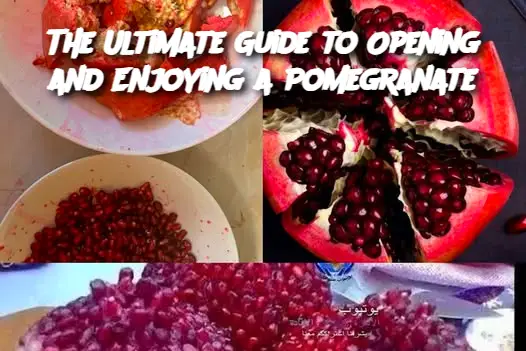Open the Pomegranate: After scoring, gently pull apart the sections of the pomegranate. The fruit naturally breaks into segments along the scores. You should now see the rows of bright, ruby-colored seeds.
Remove the Seeds: To easily remove the seeds, place the pomegranate sections into a large bowl of water. Gently pry the seeds out by pulling apart the sections with your fingers. The seeds will sink to the bottom of the bowl, while the white pith will float to the top. Discard the pith and collect the seeds.
Serve and Enjoy: Once the seeds are separated from the membrane, they are ready to be enjoyed! You can serve them immediately, or refrigerate them for later use.
Tips for Serving and Storing:
Serving Suggestions: Pomegranate seeds can be enjoyed on their own, sprinkled over yogurt, added to salads, or used as a garnish for dishes like grain bowls, desserts, or drinks. They also make a fantastic addition to smoothies and fruit salads.
Storing: Store the seeds in an airtight container in the refrigerator for up to 5 days. If you prefer, you can freeze the seeds in a single layer on a baking sheet, then transfer them to a sealed container for longer storage (up to 6 months).
Juicing: If you’re interested in making fresh pomegranate juice, you can blend the seeds and strain the juice through a fine mesh sieve to remove the pulp.
Variants:
For a Neater Experience: If you prefer not to use water for removing the seeds, you can gently tap the back of the pomegranate sections with a wooden spoon over a bowl to dislodge the seeds. This method is great for preventing splashes and keeping the juice contained.
Pomegranate-Infused Water: For a refreshing twist, add pomegranate seeds to a pitcher of water for a naturally flavored drink. Let it sit in the fridge for a couple of hours to infuse.
Baked Goods: You can also incorporate pomegranate seeds into baked goods like muffins, cakes, or cookies. The seeds add a burst of flavor and a beautiful pop of color.
FAQ:
1. How do I know if a pomegranate is ripe? A ripe pomegranate will feel heavy for its size and have a vibrant red or deep pink color. It should have a firm outer skin, though it may have some cracks. Avoid fruit with excessive blemishes or dullness, as these may indicate that it’s overripe.
2. Can I eat the pomegranate peel? No, the peel and the white pith inside the pomegranate are not edible. They are bitter and tough. Only the seeds, which are surrounded by juicy arils, are meant for consumption.
3. How can I use pomegranate juice from the seeds? Once you’ve removed the seeds, you can blend them to extract fresh juice. Simply blend the seeds until smooth, then strain the mixture through a fine sieve to remove the pulp. The resulting juice can be enjoyed on its own or mixed with other fruit juices.
4. Can I open a pomegranate in advance? Yes, you can open and store the seeds in advance. They should be refrigerated in an airtight container for up to 5 days. If you want to store them longer, freezing the seeds is a great option.
5. Are there any health benefits to eating pomegranates? Yes, pomegranates are incredibly nutritious. They are rich in antioxidants, especially anthocyanins, which have anti-inflammatory and heart-healthy benefits. Pomegranates also provide a good source of Vitamin C, fiber, and potassium, making them a great addition to a balanced diet.
Pomegranates are not only delicious but also versatile, adding both flavor and nutrients to a variety of dishes. Now that you know the best way to open and eat a pomegranate, you can enjoy this remarkable fruit with ease and incorporate it into your meals. Happy snacking!
ADVERTISEMENT

